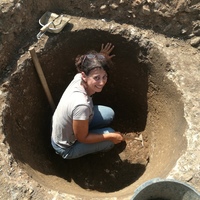Agnese Livia Fischetti
University of Groningen, Groningen Institute of Archaeology, Department Member
- University of Groningen, Archaeology, Department MemberRoyal Netherlands Institute in Rome, Ancient Studies, Department Memberadd
- Classical Archaeology, Ceramics (Archaeology), Ancient Topography (Archaeology), Topografia, Roman Archaeology, Archaeology of Latium, and 9 moreRoman Pottery, Topography of Ancient Rome (Archaeology), Archaeology, Archeologia, Latium vetus, Landscape Archaeology, Topografia Antica, Pottery (Archaeology), and Etruscan Archaeologyedit
- Ph.D. in Landscape archaeology, restorer, potter. My main research fields are Landscape Archaeology, Ancient Rome and... morePh.D. in Landscape archaeology, restorer, potter. My main research fields are Landscape Archaeology, Ancient Rome and Latium, Alban Hills, Middle Tiber Valley, Greek and Roman pottery, Roman architecture, experimental archaeologyedit
This paper examines the life cycle of cooking jars from a well of a rural farm in Ciampino, Rome, dated to the Mid-Republican period (4 th-3 rd centuries B.C.E.). Towards this aim, 39 cooking jars were selected and analysed combining... more
This paper examines the life cycle of cooking jars from a well of a rural farm in Ciampino, Rome, dated to the Mid-Republican period (4 th-3 rd centuries B.C.E.). Towards this aim, 39 cooking jars were selected and analysed combining detailed macroscopic observation and thin section petrography. More specifically, thin section petrography was used to reconstruct the production technology of the cooking jars, including raw materials, paste recipes, forming and firing technology. Macroscopic observation of the cooking jars serves to identify evidence for use and discard, and focuses on vessel completeness, accretion, and attrition. The results suggest that most jars from the well were produced in the region of the Alban Hills (Colli Albani), while a minority seems to have been imported from the Tiber Valley region, north of Rome. Hand specimen observation confirmed that the jars were almost complete, consisting of few and large fragments; they were used very little, if at all, indicating that their deposition in the well was structured and occurred rapidly. Combined with other evidence from the well, comprising Black Gloss 'Herakles' bowls, it is suggested that the production, use and discard of the cooking jars formed part of the ritual closure of the well.
This short paper was the subject of a poster describing the latest findings from the villa of Q. V. Pollione, on the slopes of Tusculum. Comparing the 19th-century excavations with modern ones provides a broader picture of agricultural... more
This short paper was the subject of a poster describing the latest findings from the villa of Q. V. Pollione, on the slopes of Tusculum. Comparing the 19th-century excavations with modern ones provides a broader picture of agricultural production and the probable production of coloured glass
This article presents some results of research aimed at reconstructing the ancient road network that led from the slopes of the Alban Hills to Rome. The comparative analysis of ancient cartography, toponymy and recent archaeological... more
This article presents some results of research aimed at reconstructing the ancient road network that led from the slopes of the Alban Hills to Rome.
The comparative analysis of ancient cartography, toponymy and recent archaeological findings has made it possible to identify on ancient maps the places where ruins are still visible today. Conversely, it was also sometimes possible to identify the exact location of archaeological features that were present on ancient maps but are no longer visible in today's landscape
The comparative analysis of ancient cartography, toponymy and recent archaeological findings has made it possible to identify on ancient maps the places where ruins are still visible today. Conversely, it was also sometimes possible to identify the exact location of archaeological features that were present on ancient maps but are no longer visible in today's landscape
The short paper presented as a poster at the conference on the Mid-Republican Age in Latium concerns a first description of the site of via Romana Vecchia. In particular, it focuses on the votive deposit that filled a well during a phase... more
The short paper presented as a poster at the conference on the Mid-Republican Age in Latium concerns a first description of the site of via Romana Vecchia. In particular, it focuses on the votive deposit that filled a well during a phase of change in the structure and function of the site. The analysis of the ceramic classes, the unique shapes and sizes of the vessels, the presence of graffiti and animal bones, suggest the nature of the deposit and the deity celebrated in it. In addition, it was possible to obtain some information on the associated structures and the state of the ownership
Research Interests:
The Colli Albani is a region close to Rome that has been extensively investigated in recent decades. Combining data from latest excavation campaigns and legacy data, this research focuses on the specific topics of the communication routes... more
The Colli Albani is a region close to Rome that has been extensively investigated in recent decades.
Combining data from latest excavation campaigns and legacy data, this research focuses on the specific topics of the communication routes and settlement dynamics on the western slopes of the Alban crater
Combining data from latest excavation campaigns and legacy data, this research focuses on the specific topics of the communication routes and settlement dynamics on the western slopes of the Alban crater
